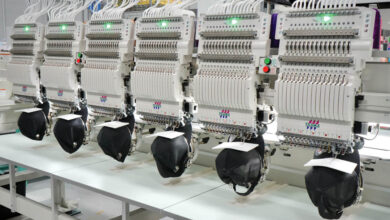No matter how it occurs, birdnesting generally means there’s a problem with tension. Most commonly, when someone refers to a birdnest, they are talking about a buildup of thread between the garment and the needle plate. It’s caused by an imbalance that leads to too much thread passing through to the back of the workpiece. This can be the result of overly loose top tension; overly high bobbin tension; improper threading; and a dirty, linty, or otherwise choked thread path under the needle plate.
Birdnesting on the top of the piece can be due to an imbalance of the tension in the other direction-having too little bobbin tension, too much top tension, a dirty thread path in the upper part of the machine, or by having some obstruction keeping the thread from moving to the back of the piece. The last of these reasons is likely what you see with small lettering.
Small stitches that penetrate too close to the previous needle drop and stitches that are too dense can lead to the needle encountering extra resistance and friction as it passes through your garment. This friction can lead to the thread being arrested as it passes to the bottom, essentially increasing top tension, and/or you could be seeing a complete inability for it to pass through, which some refer to as knotting, though the thread is, of course, not being tied in a knot. If you have excessively short stitches in your piece or you are compensating for issues in clarity on the small lettering by adding additional density, you might find loops and nesting as a result.
—ErichCampbell.com



